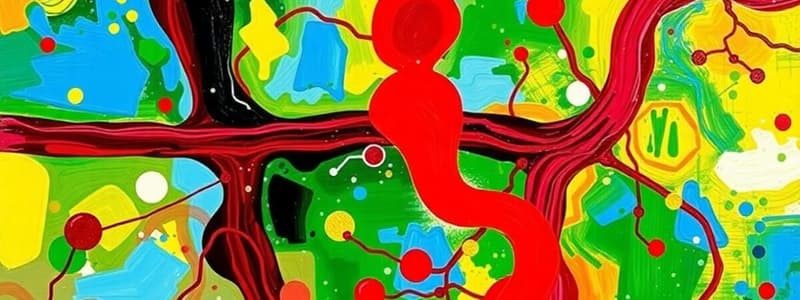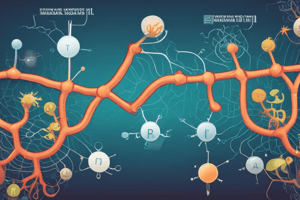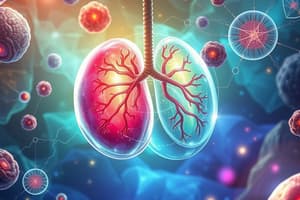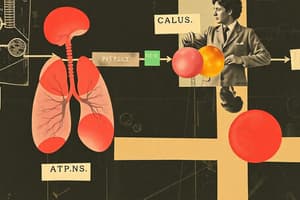Podcast
Questions and Answers
What initiates the formation of ATP during the proton flow through ATP synthase?
What initiates the formation of ATP during the proton flow through ATP synthase?
- The release of inorganic phosphate from the F₁ component
- The conversion of pyruvate to glucose
- The influx of protons leading to mechanical rotation of the c-ring (correct)
- The direct binding of ADP to the F₁ component
Which of the following statements about glycolysis is accurate?
Which of the following statements about glycolysis is accurate?
- Glycolysis exclusively occurs in the mitochondria of cells.
- Glycolysis requires oxygen to generate ATP.
- Glycolysis is an anabolic process that synthesizes glucose from ADP.
- Glycolysis converts glucose into pyruvate, producing ATP in the process. (correct)
Which component of ATP synthase directly converts the mechanical energy from proton flow into chemical energy?
Which component of ATP synthase directly converts the mechanical energy from proton flow into chemical energy?
- F₁ component (correct)
- Proton gradient
- c-ring
- F₀ component
What is the primary purpose of gluconeogenesis in carbohydrate metabolism?
What is the primary purpose of gluconeogenesis in carbohydrate metabolism?
What role does the electrochemical potential play in proton flow through ATP synthase?
What role does the electrochemical potential play in proton flow through ATP synthase?
Which enzyme in the heme synthesis pathway is primarily regulated by negative feedback inhibition from heme levels?
Which enzyme in the heme synthesis pathway is primarily regulated by negative feedback inhibition from heme levels?
How does low iron availability affect the activity of Aminolevulinic Acid Synthase (ALAS)?
How does low iron availability affect the activity of Aminolevulinic Acid Synthase (ALAS)?
Which factor directly inhibits the activity of Aminolevulinic Acid Dehydratase (ALAD)?
Which factor directly inhibits the activity of Aminolevulinic Acid Dehydratase (ALAD)?
What determines the activity of Uroporphyrinogen Decarboxylase in the heme synthesis pathway?
What determines the activity of Uroporphyrinogen Decarboxylase in the heme synthesis pathway?
Which of the following statements regarding ferrochelatase's regulation is true?
Which of the following statements regarding ferrochelatase's regulation is true?
What is the primary purpose of substrate-level phosphorylation in metabolism?
What is the primary purpose of substrate-level phosphorylation in metabolism?
Which statement accurately describes the role of NADH and FADH₂ in the electron transport chain?
Which statement accurately describes the role of NADH and FADH₂ in the electron transport chain?
How do feedback mechanisms regulate metabolism?
How do feedback mechanisms regulate metabolism?
What is the significance of chemiosmosis in oxidative phosphorylation?
What is the significance of chemiosmosis in oxidative phosphorylation?
What is the primary way that oxidative phosphorylation contributes to ATP production?
What is the primary way that oxidative phosphorylation contributes to ATP production?
Which of the following best describes anaplerotic reactions?
Which of the following best describes anaplerotic reactions?
Where does the electron transport chain primarily take place?
Where does the electron transport chain primarily take place?
How does the body remove metabolic waste produced during respiration?
How does the body remove metabolic waste produced during respiration?
What does the term 'gluconeogenesis' specifically refer to?
What does the term 'gluconeogenesis' specifically refer to?
Which of the following describes the primary importance of gluconeogenesis?
Which of the following describes the primary importance of gluconeogenesis?
Which molecule is primarily produced during oxidative deamination?
Which molecule is primarily produced during oxidative deamination?
Which coenzyme is crucial for the process of transamination?
Which coenzyme is crucial for the process of transamination?
What is the fate of nitrogen from amino acids in the body?
What is the fate of nitrogen from amino acids in the body?
In which part of the cell does the urea cycle initially occur?
In which part of the cell does the urea cycle initially occur?
Which substance serves as a temporary storage of amino groups during transamination?
Which substance serves as a temporary storage of amino groups during transamination?
What is the primary source of carbon atoms in the synthesis of urea?
What is the primary source of carbon atoms in the synthesis of urea?
What is produced from pyruvate during the gluconeogenesis process?
What is produced from pyruvate during the gluconeogenesis process?
Which enzyme is primarily responsible for the removal of amino groups during oxidative deamination?
Which enzyme is primarily responsible for the removal of amino groups during oxidative deamination?
Which hormone is responsible for stimulating beta-oxidation during periods of fasting?
Which hormone is responsible for stimulating beta-oxidation during periods of fasting?
What effect does high ATP levels have on beta-oxidation?
What effect does high ATP levels have on beta-oxidation?
Which statement correctly describes the role of malonyl-CoA in the regulation of beta-oxidation?
Which statement correctly describes the role of malonyl-CoA in the regulation of beta-oxidation?
During which state is beta-oxidation downregulated and carbohydrate metabolism favored?
During which state is beta-oxidation downregulated and carbohydrate metabolism favored?
What is the primary function of ketone bodies when glucose is scarce?
What is the primary function of ketone bodies when glucose is scarce?
Which of the following is NOT a type of ketone body?
Which of the following is NOT a type of ketone body?
What is the main regulatory enzyme in the process of ketogenesis?
What is the main regulatory enzyme in the process of ketogenesis?
What promotes ketone body production during periods of low carbohydrate availability?
What promotes ketone body production during periods of low carbohydrate availability?
Which statement accurately describes the relationship between hemoglobin structure and function?
Which statement accurately describes the relationship between hemoglobin structure and function?
In which way does hemoglobin contribute to pH regulation in the blood?
In which way does hemoglobin contribute to pH regulation in the blood?
What role does cooperative binding play in oxygen transport by hemoglobin?
What role does cooperative binding play in oxygen transport by hemoglobin?
Which of the following statements about the heme group's iron atom is correct?
Which of the following statements about the heme group's iron atom is correct?
What is the primary function of hemoglobin in relation to carbon dioxide?
What is the primary function of hemoglobin in relation to carbon dioxide?
Which chain types are primarily found in adult hemoglobin?
Which chain types are primarily found in adult hemoglobin?
Where does the binding of oxygen to hemoglobin primarily occur?
Where does the binding of oxygen to hemoglobin primarily occur?
What is the maximum number of oxygen molecules that one hemoglobin molecule can bind?
What is the maximum number of oxygen molecules that one hemoglobin molecule can bind?
Flashcards
What is oxidative phosphorylation?
What is oxidative phosphorylation?
The process of generating ATP by transferring electrons in the electron transport chain (ETC) and creating a proton gradient.
What is the 'oxidative' part?
What is the 'oxidative' part?
The oxidation reactions that occur in the electron transport chain (ETC).
What is the 'phosphorylation' part?
What is the 'phosphorylation' part?
The addition of a phosphate group (Pi) to ADP to form ATP.
Where does oxidative phosphorylation occur?
Where does oxidative phosphorylation occur?
Signup and view all the flashcards
What is the electron transport chain (ETC)?
What is the electron transport chain (ETC)?
Signup and view all the flashcards
How does the ETC create a proton gradient?
How does the ETC create a proton gradient?
Signup and view all the flashcards
What is chemiosmosis?
What is chemiosmosis?
Signup and view all the flashcards
What's the function of oxidative phosphorylation?
What's the function of oxidative phosphorylation?
Signup and view all the flashcards
Glycolysis
Glycolysis
Signup and view all the flashcards
Gluconeogenesis
Gluconeogenesis
Signup and view all the flashcards
Cellular Respiration
Cellular Respiration
Signup and view all the flashcards
Catabolic Process
Catabolic Process
Signup and view all the flashcards
Anabolic Process
Anabolic Process
Signup and view all the flashcards
Pyruvate to Glucose Conversion
Pyruvate to Glucose Conversion
Signup and view all the flashcards
Production of Acetyl-CoA
Production of Acetyl-CoA
Signup and view all the flashcards
β-oxidation
β-oxidation
Signup and view all the flashcards
Transamination
Transamination
Signup and view all the flashcards
Oxidative Deamination
Oxidative Deamination
Signup and view all the flashcards
Urea Cycle
Urea Cycle
Signup and view all the flashcards
Oxidative Phosphorylation
Oxidative Phosphorylation
Signup and view all the flashcards
TCA Cycle
TCA Cycle
Signup and view all the flashcards
Beta-oxidation
Beta-oxidation
Signup and view all the flashcards
How do free fatty acids affect beta-oxidation?
How do free fatty acids affect beta-oxidation?
Signup and view all the flashcards
How does insulin affect beta-oxidation?
How does insulin affect beta-oxidation?
Signup and view all the flashcards
How does glucagon affect beta-oxidation?
How does glucagon affect beta-oxidation?
Signup and view all the flashcards
What is the role of CPT I in beta-oxidation?
What is the role of CPT I in beta-oxidation?
Signup and view all the flashcards
What are ketone bodies?
What are ketone bodies?
Signup and view all the flashcards
What is ketogenesis?
What is ketogenesis?
Signup and view all the flashcards
What is the function of ketone bodies?
What is the function of ketone bodies?
Signup and view all the flashcards
What is heme degradation?
What is heme degradation?
Signup and view all the flashcards
Where does heme degradation begin?
Where does heme degradation begin?
Signup and view all the flashcards
What is the first step in heme degradation?
What is the first step in heme degradation?
Signup and view all the flashcards
How is biliverdin converted to bilirubin?
How is biliverdin converted to bilirubin?
Signup and view all the flashcards
What happens to bilirubin after its formation?
What happens to bilirubin after its formation?
Signup and view all the flashcards
What is Hemoglobin?
What is Hemoglobin?
Signup and view all the flashcards
Globin Proteins
Globin Proteins
Signup and view all the flashcards
Heme Group
Heme Group
Signup and view all the flashcards
Iron Atom in Heme
Iron Atom in Heme
Signup and view all the flashcards
How does Hemoglobin Transport Oxygen?
How does Hemoglobin Transport Oxygen?
Signup and view all the flashcards
What else does Hemoglobin do besides oxygen?
What else does Hemoglobin do besides oxygen?
Signup and view all the flashcards
Oxygen-Binding Sites in Hemoglobin
Oxygen-Binding Sites in Hemoglobin
Signup and view all the flashcards
Cooperative Binding in Hemoglobin
Cooperative Binding in Hemoglobin
Signup and view all the flashcards
Study Notes
Final Exam Information
- Duration: 2 hours
- Exam type: Closed-book
- Calculators: Bring non-programmable calculators according to HKMU approved list
- Topics covered: Lectures 1-11 (mainly focus on lectures 6-11)
- Weight: 50% of overall grade
Final Exam Structure
- Multiple Choice Questions (20%): 20 questions, each worth 1 mark
- Short Questions (40%): 7 questions, marks vary by question
- Long Questions (40%): 5 questions, each worth 10 marks, select 4 to answer
Example of Short Questions
- Name the metabolite or enzyme from 1 to 6 in the provided diagram of the TCA cycle (diagram on page 4)
- Name five important enzymes in oxidative phosphorylation. Give one disorder related to dysfunction of oxidative phosphorylation. (page 5)
- What are the overall products of the TCA cycle? How do these products contribute to energy production? (page 5)
- Describe the four levels of protein structure. (page 5)
Example of Long Questions
- A 45-year-old male presents to the emergency department after several days of severe fasting and significant weight loss. He has a type 2 diabetes history and reports fatigue, weakness, and confusion. Blood tests reveal elevated ketone levels and high blood urea nitrogen. Identify two metabolic processes regarding the elevated ketone levels and high blood urea nitrogen in this patient. (page 6)
- How will the activity of acyl-CoA dehydrogenase change in this patient? Why? (page 6)
- For patients with type 2 diabetes, insulin levels often become insufficient to effectively manage blood glucose utilization. What is the most likely disorder this patient will develop if his diabetic condition is not well-controlled? Why? (page 6)
Lecture 1: Water and Aqueous System
- Chemical formula: H2O
- Water is a polar molecule
- Polarity allows hydrogen bonding between water molecules.
- Important properties: Cohesion, adhesion, high boiling point, high specific heat, and excellent solvent for polar molecules
- Water can act as an acid or a base due to its polar structure.
- Autoionization of water: H2O + H2O ↔ H3O+ + OH–
- Equilibrium constant (Kw) at 25°C: 1.0 x 10-14
- In pure water: [H+] = [OH–] = 1.0 x 10-7 M
- Buffers resist changes in pH.
- A buffer is a weak acid and its conjugate base, or a pair of a weak base and its conjugate acid.
- Examples of buffers: phosphate buffers
Lecture 2: Carbohydrates, Proteins, and Lipids
- Carbohydrates: glucose, galactose, mannose, fructose, ribose, deoxyribose
- Monosaccharides: single sugar units
- Disaccharides: two sugar units linked together
- Oligosaccharides: 3-10 sugar units
- Polysaccharides: many sugar units
- Proteins: composed of amino acids, 9 non-polar and 6 polar amino acids also includes positively and negatively charged amino acids; Primary, Secondary, Tertiary, Quaternary structure
- Lipids: Glycerophospholipids, Sphingolipids, Glycolipids, Fatty Acids (saturated and unsaturated (monounsaturated, polyunsaturated));
- Polyunsaturated fatty acids (PUFAs), including omega-3 and omega-6 fatty acids
Lecture 3: Nucleic Acids
- DNA: double helix structure, made of deoxyribose sugar and phosphate groups, with bases (A, T, C, G). Adenine pairs with thymine, guanine pairs with cytosine
- RNA: Single stranded structure, made of ribose sugars and phosphate groups, with bases (A, U, C, G). Adenine pairs with uracil, and guanine pairs with cytosine
- Functions of DNA: store genetic information, transmit genetic material
- Functions RNA: instruction of protein synthesis, various roles in protein synthesis
Lecture 4: Metabolism and Energy I: TCA Cycle
- The TCA cycle is a series of chemical reactions in the mitochondrial matrix that oxidizes acetyl-CoA, producing energy (ATP)
- Acetyl-CoA is a key intermediate in linking glycolysis and the TCA cycle.
- Products of each acetyl-CoA molecule in the TCA cycle are 2 CO2, 3 NADH, 1 FADH2, 1 GTP/ATP.
- TCA cycle roles: energy production, formation of metabolic intermediates, linking metabolic pathways
Lecture 5: Metabolism and Energy II: Oxidative Phosphorylation
- ATP production process via electron transport chain
- Electron transport chain (ETC) uses energy from electrons to create a proton gradient
- Chemiosmosis: protons move back across the inner mitochondrial membrane, driving ATP synthesis
- Function of oxidative phosphorylation: ATP production, cellular respiration integration, metabolic regulation, heat generation
Lecture 6: Carbohydrate Metabolism: Part I - Glycolysis
- Glycolysis: breakdown of glucose to pyruvate in the cytoplasm
- Two phases of glycolysis: preparatory phase (steps 1-5), payoff phase (steps 6-10)
- Key steps: glucose phosphorylation, isomerization, phosphorylation, cleavage, isomerization, oxidation, transfer of phosphate, isomerization, dehydration, transfer of phosphate
- Glycolysis products: 2 pyruvate, 2 NADH, and 2 ATP
- Glycolysis regulation: influenced by substrate availability, feedback inhibition
Lecture 7: Protein and Lipid Metabolism
- Protein and lipid metabolism are critical parts of overall metabolism.
- The catabolism of various biomolecules converts them into usable energy intermediates.
Lecture 8: Hemoglobin
- Hemoglobin: a globular protein in red blood cells that transports oxygen through blood
- Basic components: globin chains (alpha and beta), heme group, iron atom
- Function: oxygen transport, carbon dioxide transport, pH regulation
Lecture 9: Enzyme I: Introduction to Enzymes
- Enzymes are biological catalysts that speed up biochemical reactions
- They act by lowering activation energy
- Enzymes have specific active sites for substrate binding.
Lecture 10: Enzyme II: Enzyme Kinetics and Inhibitors
- Enzyme kinetics: study of enzyme reaction rates and their dependence on substrate concentration
- Michaelis-Menten equation: describes the relationship between reaction velocity, substrate concentration, and enzyme properties
- Enzyme inhibitors: molecules that can bind to the enzyme and reduce its activity
Lecture 11: Enzyme III: Enzyme Diagnostics and Assay
- Liver enzymes, cardiac enzymes, and pancreatic enzymes in diagnostics
Studying That Suits You
Use AI to generate personalized quizzes and flashcards to suit your learning preferences.




